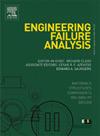不规则孔洞对预应力混凝土圆筒管承重机理和承载能力的影响
IF 5.7
2区 工程技术
Q1 ENGINEERING, MECHANICAL
引用次数: 0
摘要
本研究探讨了不规则孔洞对预应力混凝土圆筒管(PCCP)承载机理和承载能力的影响。对含有多个不规则孔洞的 PCCP 试样进行了内压试验,并进行了有限元数值模拟,以探讨这些孔洞的影响。结果表明,不规则孔洞的存在造成了明显的各向异性应力分布,尤其是在混凝土芯的内壁,孔洞周围应力集中。裂缝在拉钉端附近产生,并随着内压的增加向轴向扩展。PCCP 的承载过程分为三个阶段:(1) 预应力钢丝承受大部分荷载;(2) 混凝土在承受拉应力时开始承受部分荷载;(3) 混凝土发生塑性破坏,将荷载转移到钢筒和预应力钢丝上。带有多个不规则孔洞的 PCCP 模型在使用极限状态下的内部压力为 0.23 兆帕,仅为完整模型(0.87 兆帕)的 26.4%。不过,两种模型的极限承载能力差别很小。这些发现强调了及时修复的必要性,以防止带有不规则孔洞的 PCCP 侵蚀恶化。本文章由计算机程序翻译,如有差异,请以英文原文为准。
Effects of irregular holes on load-bearing mechanism and capacity in prestressed concrete cylinder pipes
This study investigates the effects of irregular holes on the load-bearing mechanism and capacity of prestressed concrete cylinder pipes (PCCP). An internal pressure test was performed on a PCCP specimen containing multiple irregular holes, and a finite element numerical simulation was conducted to explore the impact of these holes. The results indicated that the presence of irregular holes caused significant anisotropic stress distribution, particularly at the inner wall of the concrete core, with stress concentrations around the holes. Cracks were initiated near the spigot end and propagated axially as the internal pressure increased. The load-bearing process of the PCCP evolved in three stages: (1) the prestressed wires bore the majority of the load, (2) the concrete began sustaining a portion of the load as it experienced tensile stress, and (3) the concrete underwent plastic damage, transferring the load to the steel cylinder and prestressed wires. The internal pressure of PCCP model with multiple irregular holes associated with the serviceability limit-states was 0.23 MPa, representing only 26.4 % of the intact model, which was 0.87 MPa. However, the difference in ultimate load-bearing capacity between the two models was minimal. These findings underscore the necessity of timely repairs to prevent the worsening of erosion in PCCPs with irregular holes.
求助全文
通过发布文献求助,成功后即可免费获取论文全文。
去求助
来源期刊

Engineering Failure Analysis
工程技术-材料科学:表征与测试
CiteScore
7.70
自引率
20.00%
发文量
956
审稿时长
47 days
期刊介绍:
Engineering Failure Analysis publishes research papers describing the analysis of engineering failures and related studies.
Papers relating to the structure, properties and behaviour of engineering materials are encouraged, particularly those which also involve the detailed application of materials parameters to problems in engineering structures, components and design. In addition to the area of materials engineering, the interacting fields of mechanical, manufacturing, aeronautical, civil, chemical, corrosion and design engineering are considered relevant. Activity should be directed at analysing engineering failures and carrying out research to help reduce the incidences of failures and to extend the operating horizons of engineering materials.
Emphasis is placed on the mechanical properties of materials and their behaviour when influenced by structure, process and environment. Metallic, polymeric, ceramic and natural materials are all included and the application of these materials to real engineering situations should be emphasised. The use of a case-study based approach is also encouraged.
Engineering Failure Analysis provides essential reference material and critical feedback into the design process thereby contributing to the prevention of engineering failures in the future. All submissions will be subject to peer review from leading experts in the field.
 求助内容:
求助内容: 应助结果提醒方式:
应助结果提醒方式:


